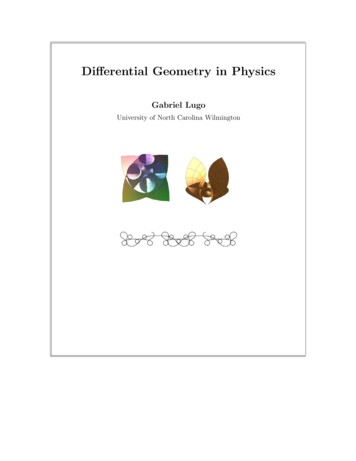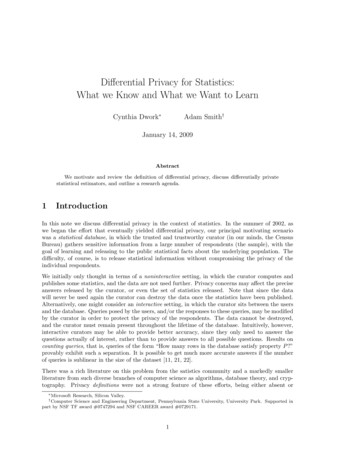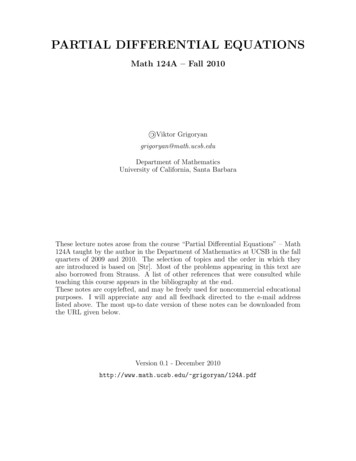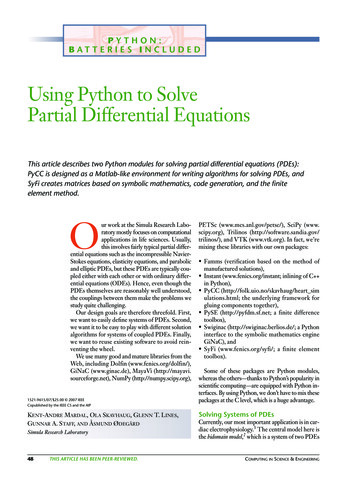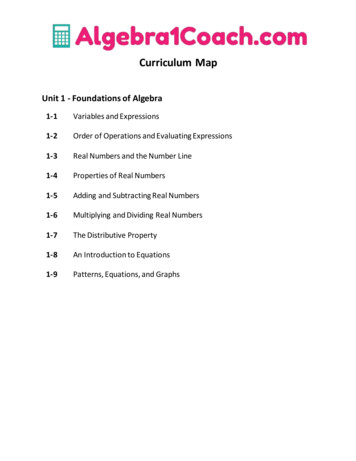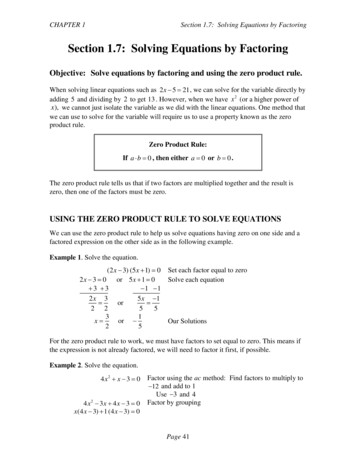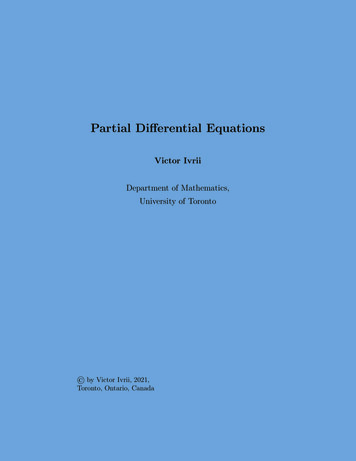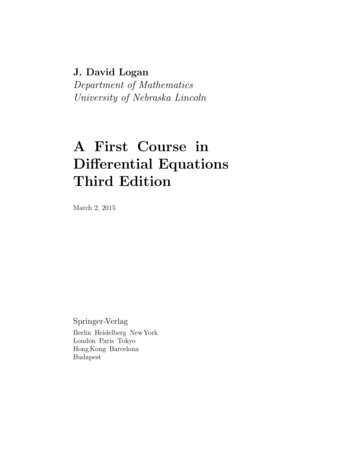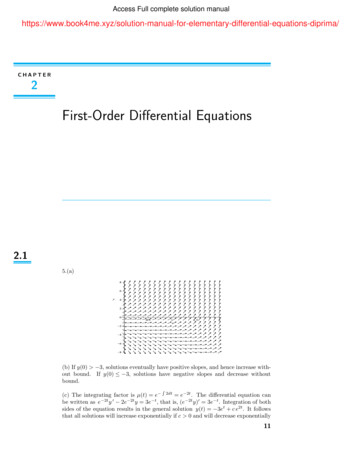
Transcription
Access Full complete solution First-Order Differential Equations2.15.(a)(b) If y(0) 3, solutions eventually have positive slopes, and hence increase without bound. If y(0) 3, solutions have negative slopes and decrease withoutbound.R(c) The integrating factor is µ(t) e 2dt e 2t . The differential equation canbe written as e 2t y 0 2e 2t y 3e t , that is, (e 2t y)0 3e t . Integration of bothsides of the equation results in the general solution y(t) 3et c e2t . It followsthat all solutions will increase exponentially if c 0 and will decrease exponentially11
12Chapter 2. First-Order Differential Equationsif c 0. Letting c 0 and then t 0, we see that the boundary of these behaviorsis at y(0) 3.6.(a)(b) For y 0 , the slopes are all positive, and hence the corresponding solutionsincrease without bound. For y 0 , almost all solutions have negative slopes, andhence solutions tend to decrease without bound.(c) First divide both sides of the equation Rby t (t 0). From the resulting standardform, the integrating factor is µ(t) e (1/t) dt 1/t . The differential equationcan be written as y 0 /t y/t2 t e t , that is, ( y/t)0 t e t . Integration leads tothe general solution y(t) te t c t . For c 6 0 , solutions diverge, as implied bythe direction field. For the case c 0 , the specific solution is y(t) te t , whichevidently approaches zero as t .8.(a)(b) All solutions eventually have positive slopes, and hence increase without bound.(c) The integrating factor is µ(t) et/2 . The differential equation can be writtenas et/2 y 0 et/2 y/2 3t2 /2 , that is, (et/2 y/2)0 3t2 /2. Integration of both sidesof the equation results in the general solution y(t) 3t2 12t 24 c e t/2 . Itfollows that all solutions converge to the specific solution 3t2 12t 24 .
tary-differential-equations-diprima/2.11310. The integrating factor is µ(t) e2t . After multiplying both sides by µ(t),the equation can be written as (e2t y)0 t . Integrating both sides of the equationresults in the general solution y(t) t2 e 2t /2 c e 2t . Invoking the specified condition, we require that e 2 /2 c e 2 0 . Hence c 1/2 , and the solution tothe initial value problem is y(t) (t2 1)e 2t /2 .R11. The integrating factor is µ(t) e (2/t) dt t2 . Multiplying both sides by µ(t),the equation can be written as (t2 y)0 cos t . Integrating both sides of the equationresults in the general solution y(t) sin t/t2 c t 2 . Substituting t π and settingthe value equal to zero gives c 0 . Hence the specific solution is y(t) sin t/t2 .14.(a)Solutions appear to grow infinitely large in absolute value, with signs depending onthe initial value y(0) a0 . The direction field appears horizontal for a0 1/8 .(b) Dividing both sides of the given equation by 3, the integrating factor is µ(t) e 2t/3 . Multiplying both sides of the original differential equation by µ(t) and integrating results in y(t) (2 e2t/3 2 e πt/2 a(4 3π) e2t/3 )/(4 3π). The qualitative behavior of the solution is determined by the terms containing e2t/3 : 2 e2t/3 a(4 3π) e2t/3 . The nature of the solutions will change when 2 a(4 3π) 0 .Thus the critical initial value is a0 2/(4 3π) .(c) In addition to the behavior described in part (a), when y(0) 2/(4 3π),the solution is y(t) ( 2 e πt/2 )/(4 3π), and that specific solution will convergeto y 0 .
14Chapter 2. First-Order Differential Equations15.(a)As t 0 , solutions increase without bound if y(1) a 0.4 , and solutions decrease without bound if y(1) a 0.4 .R(b) The integrating factor is µ(t) e (t 1)/t dt t et . The general solution of thedifferential equation is y(t) t e t c e t /t . Since y(1) a, we have that 1 c ae. That is, c ae 1. Hence the solution can also be expressed as y(t) t e t (ae 1) e t /t . For small values of t , the second term is dominant. Settingae 1 0 , the critical value of the parameter is a0 1/e .(c) When a 1/e , the solution is y(t) t e t , which approaches 0 as t 0 .R17. The integrating factor is µ(t) e (1/2) dt et/2 . Therefore the general solutionis y(t) (4 cos t 8 sin t)/5 c e t/2 . Invoking the initial condition, the specific solution is y(t) (4 cos t 8 sin t 9 e t/2 )/5 . Differentiating, it follows that y 0 (t) ( 4 sin t 8 cos t 4.5 e t/2 )/5 and y 00 (t) ( 4 cos t 8 sin t 2.25 e t/2 )/5. Setting y 0 (t) 0 , the first solution is t1 1.3643 , which gives the location of the firststationary point. Since y 00 (t1 ) 0 , the first stationary point in a local maximum.The coordinates of the point are (1.3643 , 0.82008).R18. The integrating factor is µ(t) e (2/3) dt e2t/3 , and the differential equation can be written as (e2t/3 y)0 e2t/3 t e2t/3 /2 . The general solution is y(t) (21 6t)/8 c e 2t/3 . Imposing the initial condition, we have y(t) (21 6t)/8 (y0 21/8)e 2t/3 . Since the solution is smooth, the desired intersection will bea point of tangency. Taking the derivative, y 0 (t) 3/4 (2y0 21/4)e 2t/3 /3.Setting y 0 (t) 0 , the solution is t1 (3/2) ln [(21 8y0 )/9]. Substituting into thesolution, the respective value at the stationary point is y(t1 ) 3/2 (9/4) ln 3 (9/8) ln(21 8y0 ). Setting this result equal to zero, we obtain the required initialvalue y0 (21 9 e4/3 )/8 1.643 .19.(a) The integrating factor is µ(t) et/4 , and the differential equation can bewritten as (et/4 y)0 3 et/4 2 et/4 cos 2t. After integration, we get that the generalsolution is y(t) 12 (8 cos 2t 64 sin 2t)/65 ce t/4 . Invoking the initial condition, y(0) 0 , the specific solution is y(t) 12 (8 cos 2t 64 sin 2t 788 e t/4 )/65.As t , the exponential term will decay, and the solution will oscillate aboutan average value of 12 , with an amplitude of 8/ 65 .
2.115(b) Solving y(t) 12, we obtain the desired value t 10.0658.21. The integrating factor is µ(t) e 3t/2 , and the differential equation can bewritten as (e 3t/2 y)0 3t e 3t/2 2 e t/2 . The general solution is y(t) 2t 4/3 4 et c e3t/2 . Imposing the initial condition, y(t) 2t 4/3 4 et (y0 16/3) e3t/2 . Now as t , the term containing e3t/2 will dominate the solution.Its sign will determine the divergence properties. Hence the critical value of theinitial condition is y0 16/3. The corresponding solution, y(t) 2t 4/3 4 et , will also decrease without bound.Note on Problems 24-27:Let g(t) be given, and consider the function y(t) y1 (t) g(t), in which y1 (t) 0as t . Differentiating, y 0 (t) y10 (t) g 0 (t) . Letting a be a constant, it followsthat y 0 (t) ay(t) y10 (t) ay1 (t) g 0 (t) ag(t). Note that the hypothesis on thefunction y1 (t) will be satisfied, if y10 (t) ay1 (t) 0 . That is, y1 (t) c e at . Hencey(t) c e at g(t), which is a solution of the equation y 0 ay g 0 (t) ag(t). Forconvenience, choose a 1 .24. Here g(t) 3 , and we consider the linear equation y 0 y 3 . The integratingfactor is µ(t) et , and the differential equation can be written as (et y)0 3et . Thegeneral solution is y(t) 3 c e t .26. Here g(t) 2t 5. Consider the linear equation y 0 y 2 2t 5. Theintegrating factor is µ(t) et , and the differential equation can be written as(et y)0 (2t 3)et . The general solution is y(t) 2t 5 c e t .27. g(t) 4 t2 . Consider the linear equation y 0 y 4 2t t2 .The integratingfactor is µ(t) et , and the equation can be written as (et y)0 (4 2t t2 )et . Thegeneral solution is y(t) 4 t2 c e t .28.(a) Differentiatingy and using the fundamental theorem of calculus we obtainRthat y 0 Ae p(t)dt · ( p(t)), and then y 0 p(t)y 0.(b) Differentiating y we obtain thaty 0 A0 (t)e Rp(t)dt A(t)e Rp(t)dt· ( p(t)).If this satisfies the differential equation theny 0 p(t)y A0 (t)e Rp(t)dt g(t)and the required condition follows.RR(c) Let us denoteµ(t) e p(t)dt . Then clearly A(t) µ(t)g(t)dt, and after subRstitution y µ(t)g(t)dt · (1/µ(t)), which is just Eq. (33).
16Chapter 2. First-Order Differential EquationsR30. We assume a solution of the form y A(t)e (1/t) dt A(t)e ln t A(t)t 1 ,where A(t) satisfies A0 (t) 3t cos 2t. This implies thatA(t) and the solution isy 3 cos 2t 3t sin 2t c423 cos 2t 3 sin 2t c .4t2t2.2Problems 1 through 16 follow the pattern of the examples worked in this section.The first eight problems, however, do not have an initial condition, so the integration constant c cannot be found.2. The differential equation may be written as y 2 dy sin x dx . Integratingboth sides of the equation, with respect to the appropriate variables, we obtain therelation y 1 cos x c . That is, (c cos x)y 1, in which c is an arbitraryconstant. Solving for the dependent variable, explicitly, y(x) 1/(c cos x) .3. Write the differential equation as cos 2 2y dy cos2 x dx, which also can be written as sec2 2y dy cos2 x dx. Integrating both sides of the equation, with respectto the appropriate variables, we obtain the relation tan 2y sin x cos x x c .5. The differential equation may be written as (y ey )dy (x e x )dx . Integrating both sides of the equation, with respect to the appropriate variables, weobtain the relation y 2 2 ey x2 2 e x c .6. Write the differential equation as (1 y 2 )dy x2 dx . Integrating both sides ofthe equation, we obtain the relation y y 3 /3 x3 /3 c.7. Write the differential equation as y 1 dy x 1 dx. Integrating both sides ofthe equation, we obtain the relation ln y ln x c. Solving for y explicitly givesy(x) kx. Note that k may be positive or negative due to the absolute values inthe integrated equation.8. Write the differential equation as y dy x dx. Integrating both sides of theequation, we obtain the relation (1/2)y 2 (1/2)x2 c. The explicit form of thesolution is y(x) x2 c. The initial condition would then be used to determinewhether the positive of negative solution is to be used for a specific initial valueproblem.9.(a) The differential equation is separable, with y 2 dy (1 2x)dx. Integrationyields y 1 x x2 c. Substituting x 0 and y 1/6, we find that c 6.Hence the specific solution is y 1/(x2 x 6).
2.217(b)(c) Note that x2 x 6 (x 2)(x 3) . Hence the solution becomes singular atx 2 and x 3 , so the interval of existence is ( 2, 3).12.(a) Write the differential equation as r 2 dr θ 1 dθ . Integrating both sides ofthe equation results in the relation r 1 ln θ c . Imposing the condition r(1) 2 , we obtain c 1/2 . The explicit form of the solution is r 2/(1 2 ln θ).(b)(c) Clearly, the solution makes sense only if θ 0 . Furthermore, the solutionbecomes singular when ln θ 1/2 , that is, θ e .18. The differential equation can be written as (3y 2 4)dy 3x2 dx. Integratingboth sides, we obtain y 3 4y x3 c. Imposing the initial condition, the specificsolution is y 3 4y x3 1. Referring back to the differential equation, we findthat y 0 as y 2/ 3. The respective values of the abscissas are x 1.276,1.598 . Hence the solution is valid for 1.276 x 1.598 .22.(a) Write the differential equation as y 1 (4 y) 1 dy t(1 t) 1 dt . Integrating both sides of the equation, we obtain ln y ln y 4 4t 4 ln 1 t c .Taking the exponential of both sides y/(y 4) c e4t /(1 t)4 . It follows that ast , y/(y 4) 1 4/(y 4) . That is, y(t) 4 .
tary-differential-equations-diprima/18Chapter 2. First-Order Differential Equations(b) Setting y(0) 2 , we obtain that c 1. Based on the initial condition, thesolution may be expressed as y/(y 4) e4t /(1 t)4 . Note that y/(y 4) 0 ,for all t 0. Hence y 4 for all t 0. Referring back to the differential equation,it follows that y 0 is always positive. This means that the solution is monotoneincreasing. We find that the root of the equation e4t /(1 t)4 399 is near t 2.844 .(c) Note the y(t) 4 is an equilibrium solution. Examining the local directionfield we see that if y(0) 0 , then the corresponding solutions converge to y 4 . Referring back to part (a), we have y/(y 4) [y0 /(y0 4)] e4t /(1 t)4 , fory0 6 4 . Setting t 2 , we obtain y0 /(y0 4) (3/e2 )4 y(2)/(y(2) 4). Now sincethe function f (y) y/(y 4) is monotone for y 4 and y 4 , we need onlysolve the equations y0 /(y0 4) 399(3/e2 )4 and y0 /(y0 4) 401(3/e2 )4 . Therespective solutions are y0 3.6622 and y0 4.4042 . 129.(a) Observe that (4x 3y)/(2x y) 2 (y/x) [2 (y/x)]differential equation is homogeneous. Hence the(b) The substitution y x v results in v x v 0 2 v/(2 v). The transformedequation is v 0 (v 2 5v 4)/(2 v)x . This equation is separable, with generalsolution (v 4)2 v 1 c/x3 . In terms of the original dependent variable, thesolution is (4x y)2 x y c.(c) The integral curves are symmetric with respect to the origin.30.(a) The differential equation can be expressed as y 0 (1/2)(y/x) 1 (3/2)(y/x).Hence the equation is homogeneous. The substitution y xv results in xv 0 (1 5v 2 )/2v. Separating variables, we have 2vdv/(1 5v 2 ) dx/x.(b) Integrating both sides of the transformed equation yields (ln 1 5v 2 )/5 5ln x c, that is, 1 5v 2 c/ x . In terms of the original dependent variable,3the general solution is 5y 2 x2 c/ x .(c) The integral curves are symmetric with respect to the origin.
2.31931.(a) The differential equation can be expressed as y 0 (3/2)(y/x) (1/2)(y/x) 1 .Hence the equation is homogeneous. The substitution y x v results in x v 0 (v 2 1)/2v, that is, 2vdv/(v 2 1) dx/x.(b) Integrating both sides of the transformed equation yields ln v 2 1 ln x c,that is, v 2 1 c x . In terms of the original dependent variable, the generalsolution is y 2 c x2 x x2 .(c) The integral curves are symmetric with respect to the origin.2.31. Let Q(t) be the amount of dye in the tank at time t. Clearly, Q(0) 200 g.The differential equation governing the amount of dye is Q0 (t) 2Q(t)/200. Thesolution of this separable equation is Q(t) Q(0)e t/100 200e t/100 . We needthe time T such that Q(T ) 2 g. This means we have to solve 2 200e T /100 andwe obtain that T 100 ln(1/100) 100 ln 100 460.5 min.3.(a) Let Q be the amount of salt in the tank. Salt enters the tank of water at arate of 2 (1/4)(1 (1/2) sin t) 1/2 (1/4) sin t oz/min. It leaves the tank at arate of 2 Q/100 oz/min. Hence the differential equation governing the amount of
20Chapter 2. First-Order Differential Equationssalt at any time isdQ1 1Q sin t .dt2 450The initial amount of salt is Q0 50 oz. The governing differential equation islinear, with integrating factor µ(t) et/50 . Write the equation as (et/50 Q)0 et/50 (1/2 (1/4) sin t). The specific solution is Q(t) 25 (12.5 sin t 625 cos t 63150 e t/50 )/2501 oz.(b)(c) The amount of salt approaches a steady state, which is an oscillation of approximate amplitude 1/4 about a level of 25 oz.4.(a) Using the Principle of Conservation of Energy, the speed v of a particle fallingfrom a height h is given by1mv 2 mgh .2 (b) The outflow rate is (outflow cross-section area) (outflow velocity): α a 2gh .RhAt any instant, the volume of water in the tank is V (h) 0 A(u)du. The time rateof change of the volume is given by dV /dt (dV /dh)(dh/dt) A(h)dh/dt. Sincethe volume is decreasing, dV /dt α a 2gh .(c) With A(h) π, a 0.01water level π , α 0.6 , the differential equation for the ph is π(dh/dt) 0.006 π 2gh , with solution h(t) 0.000018gt2 0.006 2gh(0) t h(0). Setting h(0) 3 and g 9.8 , h(t) 0.0001764 t2 0.046 t 3, resulting inh(t) 0 for t 130.4 s.5.(a) The equation governing the value of the investment is dS/dt r S . The valueof the investment, at any time, is given by S(t) S0 ert . Setting S(T ) 2S0 , therequired time is T ln(2)/r .(b) For the case r .07 , T 9.9 yr.(c) Referring to part (a), r ln(2)/T . Setting T 8 , the required interest rate isto be approximately r 8.66%.
2.3218.(a) Using Eq.(15) we have dS/dt 0.005S (800 10t), S(0) 150, 000. Using an integrating factor and integration by parts we obtain that S(t) 560, 000 410, 000e0.005t 2000t. Setting S(t) 0 and solving numerically for t yields t 146.54 months.(b) The solution we obtained in part (a) with a general initial condition S(0) S0 is S(t) 560, 000 560, 000e0.005t S0 e0.005t 2000t. Solving the equationS(240) 0 yields S0 246, 758.9.(a) Let Q 0 r Q . The general solution is Q(t) Q0 e rt . Based on the definition of half-life, consider the equation Q0 /2 Q0 e 5730 r . It follows that 5730 r ln(1/2), that is, r 1.2097 10 4 per year. 4(b) The amount of carbon-14 is given by Q(t) Q0 e 1.2097 10t. 4(c) Given that Q(T ) Q0 /5 , we have the equation 1/5 e 1.2097 10 T . Solvingfor the decay time, the apparent age of the remains is approximately T 13, 305years.11.(a) TheR differential equation dy/dt r(t) y k is linear, with integrating factor0µ(t) e r(t)dt . Write the equation R as (µ y) k µ(t) . Integration of both sidesyields the general solution y k µ(τ )dτ y0 µ(0) /µ(t) . In this problem, theintegrating factor is µ(t) e(cos t t)/5 .(b) The population becomes extinct, if y(t ) 0 , for some t t . Referring topart (a), we find that y(t ) 0 whenZt e(cos τ τ )/5 dτ 5 e1/5 yc .0It can be shown that the integral on the left hand side increases monotonically, fromzero to a limiting value of approximately 5.0893 . Hence extinction can happen onlyif 5 e1/5 y0 5.0893 . Solving 5e1/5 yc 5.0893 yields yc 0.8333.
22Chapter 2. First-Order Differential Equations(c) Repeating the argument in part (b), it follows that y(t ) 0 whenZ t 1e(cos τ τ )/5 dτ e1/5 yc .k0Hence extinction can happen only if e1/5 y0 /k 5.0893 , so yc 4.1667 k .(d) Evidently, yc is a linear function of the parameter k .13.(a) The solution of the governing equationpsatisfies u3 u03 /( 3 α u03 t 1 ). Withthe given data, it follows that u(t) 2000/ 3 6 t/125 1 .(b)(c) Numerical evaluation results in u(t) 600 for t 750.77 s.18.(a) The differential equation for the upward motion is mdv/dt µv 2 mg,in which µ 1/1325. This equation is separable, with m/(µ v 2 mg) dv dt .Integrating both sides and invoking the initial condition, v(t) 44.133 tan(0.425 0.222 t). Setting v(t1 ) 0 , the ball reaches the maximum height at t1 1.916 s .Integrating v(t) , the position is given by x(t) 198.75 ln [cos(0.222 t 0.425)] 48.57 . Therefore the maximum height is x(t1 ) 48.56 m.(b) The differential equation for the downward motion is m dv/dt µv 2 mg .This equation is also separable, with m/(mg µ v 2 ) dv dt . For convenience,set t 0 at the top of the trajectory. The new initial condition becomes v(0) 0 .Integrating both sides and invoking the initial condition, we obtain ln((44.13 v)/(44.13 v)) t/2.25. Solving for the velocity, v(t) 44.13(1 et/2.25 )/(1 et/2.25 ). Integrating v(t), we obtain x(t) 99.29 ln(et/2.25 /(1 et/2.25 )2 ) 186.2.To estimate the duration of the downward motion, set x(t2 ) 0, resulting int2 3.276 s. Hence the total time that the ball spends in the air is t1 t2 5.192 s.
2.323(c)19.(a) Measure the positive direction of motion upward . The equation of motionis given by mdv/dt k v mg . The initial value problem is dv/dt kv/m g , with v(0) v0 . The solution is v(t) mg/k (v0 mg/k)e kt/m . Settingv(tm ) 0, the maximum height is reached at time tm (m/k) ln [(mg k v0 )/mg].Integrating the velocity, the position of the body ish mm v0 ix(t) mg t/k ( )2 g (1 e kt/m ).kkHence the maximum height reached is mg k v0m v0mxm x(tm ) g( )2 ln.kkmg(b) Recall that for δ 1 , ln(1 δ) δ δ 2 /2 δ 3 /3 δ 4 /4 . . .(c) The dimensions of the quantities involved are [k] M T 1 , [v0 ] LT 1 , [m] M and [g] LT 2 . This implies that kv0 /mg is dimensionless.23.(a) Both equations are linear and separable. Initial conditions: v(0) u cos Aand w(0) u sin A. We obtain the solutions v(t) (u cos A)e rt and w(t) g/r (u sin A g/r)e rt .(b) Integrating the solutions in part (a), and invoking the initial conditions, thecoordinates are x(t) u cos A(1 e rt )/r andy(t) gt g ur sin A hr2ug ( sin A 2 )e rt .rr2rr
tary-differential-equations-diprima/24Chapter 2. First-Order Differential Equations(c)(d) Let T be the time that it takes the ball to go 350 ft horizontally. Then fromabove, e T /5 (u cos A 70)/u cos A . At the same time, the height of the ballis given byy(T ) 160T 803 5u sin A (800 5u sin A)(u cos A 70).u cos AHence A and u must satisfy the equality u cos A 70(800 5u sin A)(u cos A 70)800 ln 803 5u sin A 10u cos Au cos Afor the ball to touch the top of the wall. To find the optimal values for u and A,consider u as a function of A and use implicit differentiation in the above equationto find thatduu(u2 cos A 70u 11200 sin A) .dA11200 cos ASolving this equation simultaneously with the above equation yields optimal valuesfor u and A: u 145.3 ft/s, A 0.644 rad. 1/224.(a) Solving equation (i), y 0 (x) (k 2 y)/y. The positive answer is chosen,since y is an increasing function of x .(b) Let y k 2 sin2 t. Then dy 2k 2 sin t cos tdt. Substituting into the equation inpart (a), we find that2k 2 sin t cos tdtcos t .dxsin tHence 2k 2 sin2 tdt dx.(c) Setting θ 2t, we further obtain k 2 sin2 (θ/2) dθ dx. Integrating both sidesof the equation and noting that t θ 0 corresponds to the origin, we obtain thesolutions x(θ) k 2 (θ sin θ)/2 and (from part (b)) y(θ) k 2 (1 cos θ)/2.(d) Note that y/x (1 cos θ)/(θ sin θ). Setting x 1 , y 2 , the solution ofthe equation (1 cos θ)/(θ sin θ) 2 is θ 1.401 . Substitution into either ofthe expressions yields k 2.193 .
2.4252.42. The function tan t is discontinuous at odd multiples of π/2. Since π/2 π 3π/2, the initial value problem has a unique solution on the interval (π/2, 3π/2).4. The function ln t is defined and continuous on the interval (0 , ) . At t 1,ln t 0, so the normal form of the differential equation has a singularity there.Also, cot t is not defined at integer multiples of π, so the initial value problem willhave a solution on the interval (1, π).6. The function f (t , y) is discontinuous along the coordinate axes, and on thehyperbola t2 y 2 1 . Furthermore, 1y ln ty f 2 yy(1 t2 y 2 )(1 t2 y 2 )2has the same points of discontinuity.7. f (t , y) is continuous everywhere on the plane. The partial derivative f / y isalso continuous everywhere.10. The equation is separable, with dy/y 2 2t dt . Integrating both sides, thesolution is given by y(t) y0 /(1 y0 t2 ). For y0 0 , solutions exist as long ast2 1/y0 . For y0 0 , solutions are defined for all t .311. The equation is separable, with dy/yp dt . Integrating both sides andinvoking the initial condition, y(t) y0 / 2y02 t 1 . Solutions exist as long as2y02 t 1 0 , that is, 2y02 t 1 . If y0 6 0 , solutions exist for t 1/2y02 . Ify0 0 , then the solution y(t) 0 exists for all t .12. The function f (t , y) is discontinuous along the straight lines t 1 and y 0 .The partial derivative f / y is discontinuous along the same lines. The equation is separable, with y dy t2 dt/(1 t3 ). Integrating and invoking the initial 1/2condition, the solution is y(t) (2/3) ln 1 t3 y02. Solutions exist as longas (2/3) ln 1 t3 y02 0, that is, y02 (2/3) ln 1 t3 . For all y0 (it can beverified that y0 0 yields a valid solution, even though Theorem 2.4.2 does not2guarantee one) , solutions exist as long as 1 t3 e 3y0 /2 . From above, we must2have t 1 . Hence the inequality may be written as t3 e 3y0 /2 1 . It follows 3y02 /21/3that the solutions are valid for (e 1) t .
26Chapter 2. First-Order Differential Equations14.Based on the direction field, and the differential equation, for y0 0 , the slopeseventually become negative, and hence solutions tend to . For y0 0, solutionsincrease without bound if t0 0 . Otherwise, the slopes eventually become negative,and solutions tend to zero. Furthermore, y0 0 is an equilibrium solution. Notethat slopes are zero along the curves y 0 and ty 3 .15.For initial conditions (t0 , y0 ) satisfying ty 3 , the respective solutions all tend tozero . For y0 9, the solutions tend to 0; for y0 9, the solutions tend to . Also,y0 0 is an equilibrium solution.16.
2.527Solutions with t0 0 all tend to . Solutions with initial conditions (t0 , y0 )to the right of the parabola t 1 y 2 asymptotically approach the parabola ast . Integral curves with initial conditions above the parabola (and y0 0)also approach the curve. The slopes for solutions with initial conditions below theparabola (and y0 0) are all negative. These solutions tend to .17.(a) No. There is no value of t0 0 for which (2/3)(t t0 )2/3 satisfies the condition y(1) 1.(b) Yes. Let t0 1/2 in Eq.(19).(c) For t0 0, y(2) (4/3)3/2 1.54.20. The assumption is φ0 (t) p(t)φ(t) 0. But then cφ0 (t) p(t)cφ(t) 0 as well.22.(a) Recalling Eq.(33) in Section 2.1,Z tc1µ(s)g(s) ds .y µ(t) t0µ(t)RtIt is evident that y1 (t) 1/µ(t) and y2 (t) (1/µ(t)) t0 µ(s)g(s) ds.(b) By definition, 1/µ(t) e y10 p(t)y1 0.Rp(t)dt. Hence y10 p(t)/µ(t) p(t)y1 . That is,Rt(c) y20 ( p(t)/µ(t)) 0 µ(s)g(s) ds µ(t)g(t)/µ(t) p(t)y2 g(t). This impliesthat y20 p(t)y2 g(t).25. Since n 3, set v y 2 . It follows that v 0 2y 3 y 0 and y 0 (y 3 /2)v 0 . Substitution into the differential equation yields (y 3 /2)v 0 εy σy 3 , which furtherresults in v 0 2εv 2σ. The latter differential equation is linear, and can be written as (ve2εt )0 2σe2εt . The solution is given by v(t) σ/ε ce 2εt . Convertingback to the original dependent variable, y v 1/2 (σ/ε ce 2εt ) 1/2 .27. The solution of the initial value problem y10 2y1 0, y1 (0) 1 is y1 (t) e 2t .Therefore y(1 ) y1 (1) e 2 . On the interval (1, ), the differential equationis y20 y2 0, with y2 (t) ce t . Therefore y(1 ) y2 (1) ce 1 . Equating thelimits y(1 ) y(1 ), we require that c e 1 . Hence the global solution of theinitial value problem is(e 2t , 0 t 1y(t) .e 1 t , t 1Note the discontinuity of the derivative( 2e 2t , 0 t 1y 0 (t) . e 1 t , t 1
28Chapter 2. First-Order Differential Equations2.51.0-a/bThe equilibrium points are y a/b and y 0, and y 0 0 when y 0 or y a/b, and y 0 0 when a/b y 0, therefore the equilibrium solution y a/bis asymptotically stable and the equilibrium solution y 0 is unstable.3.
2.5290The only equilibrium point is y 0, and y 0 0 when y 0, y 0 0 when y 0,hence the equilibrium solution y 0 is unstable.7.10-1The equilibrium points are y 0, 1 , and y 0 0 for y 1 or 0 y 1 andy 0 0 for 1 y 0 or y 1. The equilibrium solution y 0 is unstable, and theremaining two are asymptotically stable.
tary-differential-equations-diprima/30Chapter 2. First-Order Differential Equations8.20-2The equilibrium points are y 0 , 2, and y 0 0 when y 2 or y 2, andy 0 0 for 2 y 0 or 0 y 2. The equilibrium solutions y 2 and y 2are unstable and asymptotically stable, respectively. The equilibrium solution y 0is semistable.9.
First-Order Di erential Equations, 2.1, 5.(a) (b) If y(0) 3, solutions eventually have positive slopes, and hence increase with- out bound. If y(0) 3, solutions have negative slopes and decrease without bound. (c) The integrating factor is (t) e, R 2dt e2t. The di erential equation can be written as e2ty002e2ty 3et, that is, (e y) 3et.

![Introduction to SEIR Models - Indico [Home]](/img/37/0.jpg)

